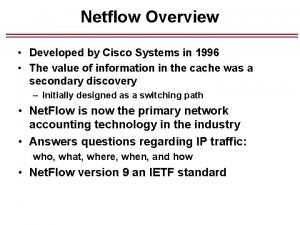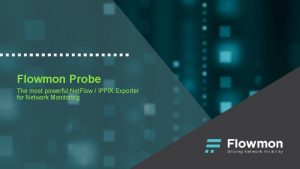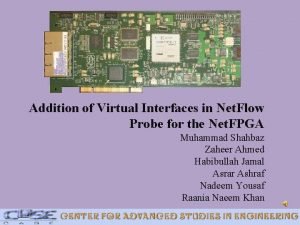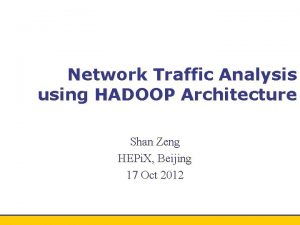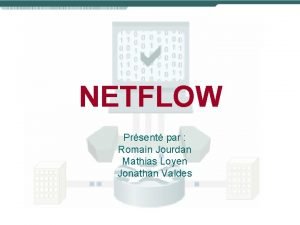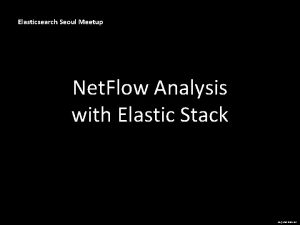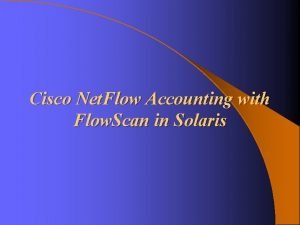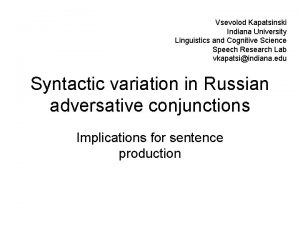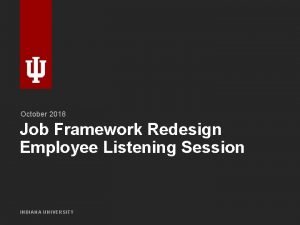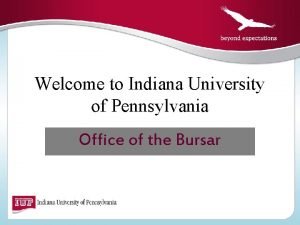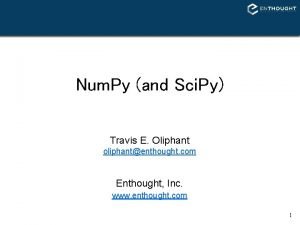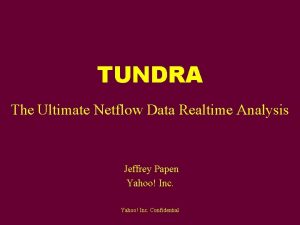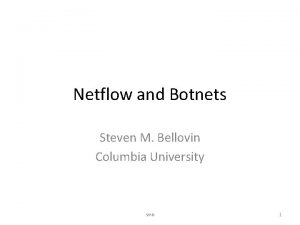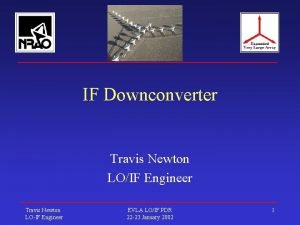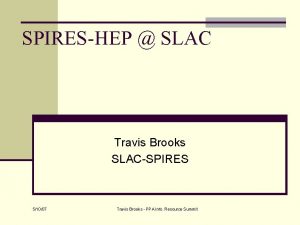NETFLOW analysis infrastructure at Indiana University Gregory Travis




















- Slides: 20

NETFLOW analysis infrastructure at Indiana University Gregory Travis Advanced Network Management Lab (ANML) Indiana University greg@iu. edu

What do we do? • Research – Build new DDo. S/IDS systems – Learn what’s going on • Operational – Support REN-ISAC – Report upstream

ANML - Network Security • Abilene NOC presented with an opportunity to partner with Asta Network and Arbor Networks via Internet 2 • Distributed Denial of Service (DDo. S) detection equipment first installed at Indianapolis core node in 2000 • DDo. S detection equipment showed *many* DDo. S incidents traversing Abilene each day • Determined that this was a potential opportunity to provide more focus on security for the research and education network space

ANML - Network Security • Indiana University leveraged the security services provided to Abilene, along with the existing Policy and Security arms of the Office of the Vice President for Information Technology, into a proposal to perform the function of the Research and Education Information Sharing and Analysis Center (REN-ISAC) • February 21 st 2003, Indiana University signed an agreement with the National Infrastructure Protection Center to provide the REN-ISAC function • Doug Pearson is the director of the REN-ISAC (www. renisac. edu)

What’s an ISAC/REN-ISAC? • ISACs (Information Sharing and Analysis centers) are cooperations of private and public entities within Department of Homeland Security • The REN-ISAC Supports U. S. higher education and research communities by providing advanced network security services • Also supports efforts to protect the national cyber infrastructure

ANML I 2 DDo. S Monitoring • Multiple Systems monitoring NETFLOW data looking for indications of attack. – Arbor Networks – Internal exploratory tools – Snort • Systems feed output into central event database

What we do with the data • Input into tools for effective exploratory data analysis for NETFLOW data: – Ad-hoc (I. e. flowtools) – Relational (Postgres) – Third Party/Commercial (Arbor) – Hybrids

Hybrid Project • Provide an SQL like query language with a data storage system that is optimized for the storage and analysis of NETFLOW. • SQL databases have great expressing capability but are slow in this type of task. • Flowtools is faster but the expression language is a bit obtuse.

Collection infrastructure I 2 Routers Indianapolis Gigapop ANML Bloomington Flow Collectors (Arbor/ANML/etc. )

How much data? • Anonymized I 2 NETFLOW repository. • Short term SQL DB. • 3 month cache of data • ~1 Terabyte of storage. • ~7000 records per second • ~600 million per Day – Large seasonal variations

DDo. S Summary Reporting

A typical day of DDo. S • Typical daily totals: – High alerts: 6 – Medium alerts: 6 – Low alerts: 43 • Severity is related to how far we exceed administrative thresholds

Worm tracking

Two types of data • We’ve been talking about anomaly tracking via NETFLOW but should also make mention of signature-based systems • Both methods have their strengths and weaknesses • Typically you will need to do both

NETFLOW • Very useful for monitoring high-volume networks • Doesn’t have wiretapping implications that signature-matching does – Data is already aggregated/depersonalized • But you can’t “see the data” which is good and bad – Sometimes difficult to know if an attack a real or just a data anomaly • Blaster example

Signature matching • Actually looking at the data on the wire to look for specific DDo. S/worm/etc. “signatures” • VERY compute intensive – Not practical “at wire speed” – Typically deployed on a per-LAN basis

“Warscoping” • ANML developing location services for wireless devices • Number of instances where it’s important to be able to physically locate wireless devices – “ 911” services – Troubleshooting – Locating nefarious actors

Other techniques we use • Honeypots – Tripwire – SEBEK • Warscoping – Geolocation

Warscope display

Sebek Analysis
 Cisco top talkers
Cisco top talkers Ipfix probe
Ipfix probe Netflow probe hardware
Netflow probe hardware Hadoop netflow
Hadoop netflow Collecteur netflow
Collecteur netflow Mrtg netflow
Mrtg netflow Moloch netflow
Moloch netflow Cisco netflow to xml
Cisco netflow to xml Indiana university intensive english program
Indiana university intensive english program Indiana university rugby
Indiana university rugby Vsevolod kapatsinski
Vsevolod kapatsinski Iu job framework redesign
Iu job framework redesign Fvsu bursar office
Fvsu bursar office Crewdson ophelia
Crewdson ophelia Contemporary health issues
Contemporary health issues Hirschi social bond theory
Hirschi social bond theory William b travis
William b travis Travis county texas gis
Travis county texas gis Travis hill abc
Travis hill abc Travis heffernan
Travis heffernan Travis e. oliphant
Travis e. oliphant
